Simple living, self-sufficiency, off-grid living, and back to the basics are having a huge comeback these days. Homesteading and backyard farming has become popular again. In this article, I (Anna) share childhood memories of how my parents lived a simple, mostly self-sufficient, urban homesteading life. How was it, how did we do it, and what have we learned from it.
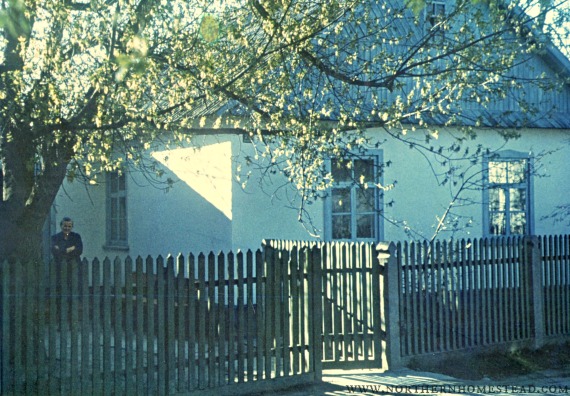
My Parents Homestead
The homestead I grew up on (picture above with my mom), would be considered a dream for many people today.
The homestead was not big, only about 1/3 of an acre, but a highly productive place. In the front were the buildings, in the back was the garden. In between some space for a dairy cow, a pig, and some chickens. Sometimes we would also raise rabbits and ducks.
The buildings were surrounded by trees. The trees gave much-needed shade and also provided food for our family. I remember just one tree, in the middle of our front yard, that had nothing edible on it but was good for shade, all the other trees were fruit trees. There were many trees, one could almost say that our house was built in an orchard. Also, the garden had trees at the corners.
The garden provided us with all the vegetables our family eat. If we could not grow it, we simply did not have it. The animals provided dairy, eggs, and meat products for our family. I grew up on a homegrown, home-raised, and home-cooked diet more than most people I know.
We were not off-grid but also not dependent on the grid. The power grid and water supply were never reliable. Many things were done by hand the old fashion way.
Simple buildings
Our house was a natural adobe brick house that my father had built. He made all the mud bricks himself first and then built the house out of them. The wall was about 1.5 feet thick. All the windows, doors, floors, and ceiling were built out of wood, also crafted by my father. No, my father was not a carpenter, but he knew how to work with wood. Our house was a simple 4 room house, with an enclosed porch, a pantry with access to the root cellar, and also a simple bathroom addition.
Opposite the house was another building complex. Here was a summer baking and cooking room with a big wood-burning oven that served for bread baking, and a huge round pot also heated with wood. To have these two cooking places in a separate room was very practical. No matter the weather my parents were able to use them. All summer long my mom baked all our bread in there. In the winter she did it in the house since we heated the stove with the built-in oven anyway. The pot was mainly used during butchering times, to boil big portions of meat and make sausage and lard.
Next was the summer kitchen. This room served as a kitchen in the summer and as an additional cold storage room in the winter. Every spring we would move the entire kitchen here, and in the fall back into the house. As a child, I thought this was really fun!
We did not have any air conditioning in the house, so having the cooking outside the main house was important to keep the house cool in the summer. And there was lots of cooking and food preservation done in the summer.
The next building in a row was the stable. There was room for a cow and its calf, pigs (only till butchering time in late fall), and the chickens. I remember the stable being smaller than our summer kitchen, maybe just because it was so crowded, then all of our animals shared the space in the winter, in order to keep it warm without any additional heating.
On one side was the cow’s place where she was chained to the feed trough. This way she could always be fed from the front and made her business in the back. In this position, she spent all winter and gave birth to her calf also.
On the other side was room for the calf and the pig. In the summer the cow had about the same amount of space outside, but she could spend the days on pasture outside of town.
Last were the coal and hay rooms, we had to store both for the winter.
Heating and water
In the middle of the house, there was a round brick stove with a big oven in the middle for baking and cooking The heater was painted black to absorb as much heat as possible. It had an integrated heat exchanger for the hydronic heating that circulated the water to the heating radiators all throughout the house, providing additional heat. The whole system ran only on the convection process.
The bathroom had two ways to heat water. For the winter the bathroom had a wood stove with a water container on top of it. Whenever a bath was desired, we would fire up the stove and have a warm space and hot water at the same time. This water was town water that only worked in the cold season when people wouldn’t use it to irrigate their garden.
For the summer a rooftop container would warm up from the sun. At the end of the day, we had warm water to shower with. Our summer water supply was very limited, so all the water had to be brought in and up to the roof, so a quick shower was all we could have.
Outhouse
The composting toilet was outside in the outhouse. We did not use buckets but had a hole in the ground. Once a hole was filled, the outhouse was moved to a new location. The old hole would be covered with some soil to decompose.
Gardening and orchard
We grew most of what we ate. Our urban lot was used mainly for gardening. The main crops were potatoes, high in yield and good for storage. Beans, beets, carrots, tomatoes, cucumbers, cabbage, and other goodies also grew here for our food supply.
The garden was divided into early, tender crops, and late crop areas. The tender crop area was fenced in, so we could start things early, or keep some crops later without the chickens going into it. The rest was free chicken run space, except during the productive months.
Because of the semi-desert climate we lived in, the whole garden needed to be irrigated. An irrigation system was in place connecting our garden, and all the gardens in the neighborhood, with a water channel coming from the mountains. Nothing would have grown without this important part.
Animals
We raised a cow for milk, who had a calf every year, one or two pigs, meat rabbits as well as chickens and other domestic birds for meat, eggs, and feathers. We did not grow the feed but had to bring it in. All the kitchen scraps were given to the animals as well. In return, the manure was composted and used in the garden.
From our own milk supply, my mom would make soft cheese, cream, and butter. Plus milk always made a quick drink or meal for us kids. Very little of the milk went to the calf. Right after birth the calf was separated from the mother and given milk in a bowl. Nither the mother cow nor the calf really knew what they were missing, or did they!?
We would make our own sausages, lard, smoked meat, and more. Chickens were there for dual purposes, laying eggs and making chicken soup at the end of the laying time. Sometimes we had ducks or geese, again for dual purposes: for meat, and the feathers were used in homemade bedding.
Food preserving and storage
To preserve food for winter was very important. We dehydrated fruit in the hot summer sun by simply spreading them out on a flat roof. This was possible since our summers were very hot and dry. We also canned fruits and vegetables and made jam. In the fall we fermented sauerkraut. The pantry was not heated, making it a great cold storage room in the winter. Dry fruits and canned goods were stored there.
The cellar was being used for keeping potatoes and other root vegetables fresh. The root cellar was a small room underneath the pantry and accessible through a hole in the pantry, covered with a wooden lid. Nothing fancy, but very effective. We stored root crops in there from harvest to harvest.
Animals were butchered in the fall so the meat could be preserved better. The meat was smoked and salted. We also had a fridge, even though it was mostly in the summer kitchen and only used as a fridge during the summer months. In the winter the room and the fridge were storage spaces for meat. In the summer we mostly ate vegetables, eggs, and dairy products, plus an occasional chicken.
Groceries
Even though we grew and raised a good amount of our food, we were not completely self-sufficient. There was no way we could possibly grow any of the grains (wheat or rice) we ate. We also bought sugar, salt, and honey. Factory-produced cheese or sausages, as well as sweets, were a seldom treat. Also, fats were the desired products.
Our health
The cost of simple living
The so-called simple living did come with a high cost. My parents were always busy doing everyday chores. Both of them were also not healthy, making the task all the more dragging.
Don’t get me wrong, I have many beautiful memories of us in the garden, growing and harvesting food. But I would lie if I romanticized it. There was no time to really enjoy any of it to the full. It was work, work, work.
A big portion of our tight budget went for buying the feed for animals. Animals need a lot of feed all through the year. Being the most labor-intense and costly part of our homesteading life, they provided about 1/4 of our diet.
It took me a while to see the cruelty of home-raised animals. Except if you have lots of natural pasture and shelter space, domestic animals often do not have a happy life. It is not always better for children to grow up around them and they are not an unconditional healthy food source.
I do not recall seeing any of our domestic animals as pets, or even as being cute. They caused a lot of hard and unpleasant work. Butchering them was a normal cycle of life, we used them for food. Contemplating whether they had a happy life would not have crossed my mind. Our cow was stiff every spring and our pigs never saw sunshine. We cared for them in a way to get the most out of them. Still, our domestic animals did have a better life and care than most farm animals of today do.
It made me think if we weren’t better off if my parents had used the space the animals needed on that small homestead for growing beans, and the money to get feed to buy nuts and seeds instead. I’m sure our life would have been much simpler, or truly simple. Back then however no one even seemed to think this way, or did they?
We ate mostly from the garden, not because we wanted to, or thought that was healthier, no, it was what was available and what our family could afford. The more products became available, the less self-sufficient we became. It shows that the “why” of simple living is much more important than the “how”.
What we have learned
Since we have seen how people lived simple yesterday, being mostly self-sufficient on our parent’s homestead (Jakob’s memories are similar) and going all the way to the conveniences of modern living, we have the advantage to choose from experience what we want to repeat, and what is better to leave in the past.
We see the value of homegrown food. There’s satisfaction and the joy that comes with it. We also see the health and taste benefits, even though homegrown and homemade food is simple, it is just so good. Growing and preserving as much as we can of what we eat makes sense.
We cherish the ability and skills that we have learned, working with our own hands, to build and make what we need.
Natural building materials, along with practical solutions for everyday chores are also something that inspires us.
We have no desire to live without electricity or running water though. Those things sound romantic as long as you have not lived them. For religious or fanatic reasons one might be happy to do it for a while, but living simply is much easier with some modern conveniences.
We are also not looking to raise animals for food. It is an expensive food source, both in labor and resources. We enjoy being a domestic animal-free homestead and eat a whole-food plant-based diet. Many of my childhood sicknesses and weakness that I struggled with for most of my life, are now gone for good. Going from white flour to freshly grounded whole grains has played a big role in it, too.
The book The Good Life by Helen and Scott Nearing chronicles 60 years of vegetarian homesteading off the grid. This might be the best solution (not just) for urban homesteading.
I’m dreaming of a world where all beings can coexist in peace. Animals are a big part of our ecosystem. Together we make the best land stewards. Together does not mean however that one has to have the ruling over the other. Humans are not better or worse than nature, we are all part of it.
To live and let live leads to a simple good life.
Do you have past experiences that have led to life choices?
We invite you to subscribe to Northern Homestead and follow us on Instagram, Facebook, or Pinterest for the latest update.
More posts you might enjoy
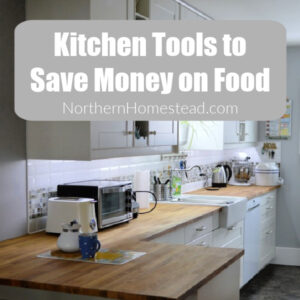
5 Kitchen Tools to Save Money on Food

DIY and Low-Cost Windows and Doors Insulation Options
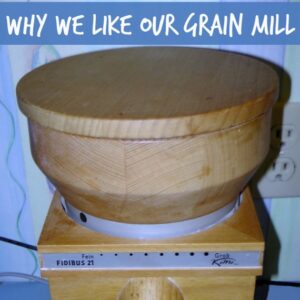
Why We Would Recommend a KoMo Fidibus Grain Mill
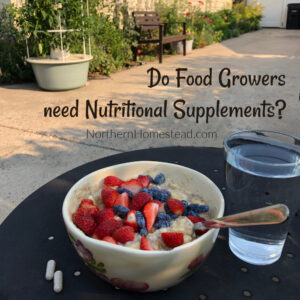
Do food growers need nutritional supplements?
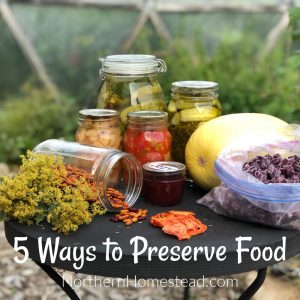
5 Ways to Preserve Vegetables, Fruits, and Herbs
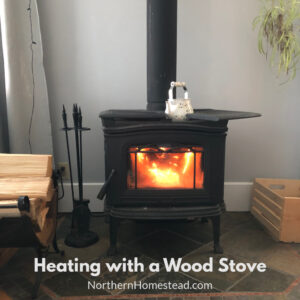
Heating your Home with a Wood Stove in Town
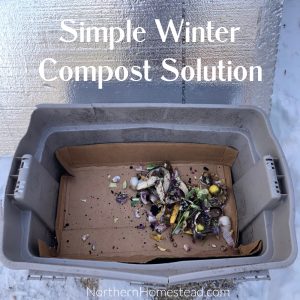
Simple Winter Compost Solution
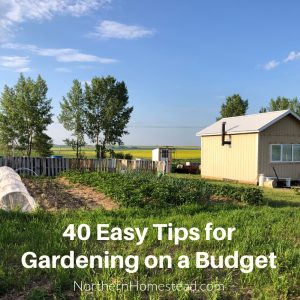
40 Easy Tips for Gardening on a Budget
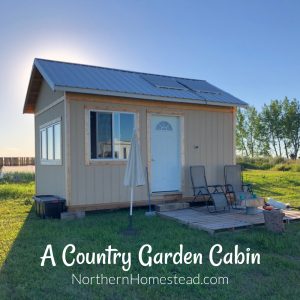
A Country Garden Cabin
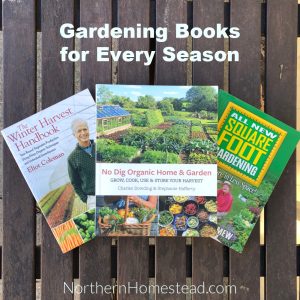


What a WONDERFUL post! There is so much LOVELY information there that is super helpful to those of us joining you in trying to get back to the soil and being self sufficient. Each of your sub topics would make a great post in themselves. Would love to see pictures of your childhood home. I’m going to have to read through it again and take notes. I’m just in awe that ALL OF THAT happened on 1/3 of an ACRE!!! Here I sit on almost 2 acres and can’t seem to figure out how to manage. Talk about an efficient home!
Thank you for your kind words. The picture is our home, with my mom in it. I wish I had pictures of everything, but we just didn’t take many pictures back than. Our homestead now is even smaller, we only have 1/8 of an acre. To have 2 acres would be great. Happy homesteading!
Wonderful! I’m really interested to know how to keep cows on that small acreage. We have about an1/2 acre that we fenced off with the idea of having a beef cow or two but so many people are telling us it won’t work. We figured we might try and find out.
On 1/3 of an acre there is no room for pasture. The cow just had a place to stay, lay down to sleep and eat. We made sure that place was warm for the winter (a stable) because the cow can not move much. It also was cleaned regularly. For the summer she would be pastured outside in the field during the day, and come back to her place at night.
And where is that house? Looks like my grandparents house back home in Slovakia. Best memories ever.
No, it is not in Slovakia. Glad you have some good memories, too.
Question regarding the calves, is that the meat you slaughtered each fall? Or were you referring to only the pigs?
Hoping to slowly build up to traditional homesteading, but my husband is balking at animals. (I was thinking rabbits, goats and chickens.) We are still in the planning stages, and will have at least an acre, hopefully 2; if our forecast follows through.
Yes, the calves were part of the meat.
We’ve been living rather simply since we built our home, earth sheltered, from native materials in 1984. Started out with one solar panel and a car battery. We’ve come a long way from that, but still live quite simply, off the grid, with our own water and fuel source (wood heat/cooking)…I imagine where you lived in this article was in one of the Stans, fairly arid country. I enjoy your blog posts…We have been moving to an elegant future, but simple. We’ve been here for 34 years now…
Love how you worded it, ‘an elegant future, but simple’. I think that’s the challenge to keep it simple for the simplicity, not for fanatic reasons to stay in the past. Not everything back then was good, but so much is worth keeping.
Considering ALL our ancestors at some point were farmers, we just have to bring up lifestyles and remember what our people of all cultures used to do. My mother was raised on a farm in Wyoming, The thing she hated and talked about most was her mother ringing chickens’ necks and them running around with a broken neck until they died. That’ was pretty horrible, and she remembers it as a small child, under 5, and that’s what stays with her. My chickens get the ax, and only have one bad minute. Less than a minute. Seconds. Otherwise they get a yard and greens and a complete pellet with minerals, and D, and electrolyte in their water year round, and a lamp in the winter. And they are pretty friendly and come up for their goodies and treats (and leftovers, they can handle what none of the other animals can’t). Eggs from green fed chickens are rich in vitamin K2 that’s what drives calcium into our bones and teeth. Also It sounds like you prefer a vegan lifestyle, but consider raising just eggs and milk, these animals do NOT have to suffer, it’s your choice. You are in charge. That’s what I did. I was horrified at the factory farms, and I tried veganism. THAT did not go well. So I raise my own, and they only have one bad day. Really, only seconds. Most of them don’t have to face that. Most are milk and egg producers. I embrace the live pasture based principle. Even the rabbits are out on the ground, but I have to carry their greens to them. They do much better socially that way though. I got this group from a Mennonite who had not had babies for 3 years. So they were 3 years old. But he kept them in a dark, battery caged shed. As soon as we let them out in the open air pen, they were finding their feet, and each other. And soon, we had babies. i think they had vitamin D deficiency (no sun) and depression (SAD- Seasonal Affective Disorder- but kept in the dark, no sun, same result). Vitamin K2 shows itself in them by neon yellow fat. Chickens get neon yellow skin and fat, and orange egg yolks. Cows get very yellow milk on greens, live greens, and goats get light yellow milk. Weston Price called this Factor X in the 1930’s but he noted how important it was for development and skeletal strength and immunity. Since CAFO cows are locked away out of the sun, and grass, and fed silage, which ruins the beta carotene and K1 content, the milk is white, that means deficient. ( those nutrients are what cause fats to turn yellow. )
Montana organic Garden.
Hi,
It was very interesting to read all comments for living in your own backyard garden in the country. I am learning a lot from your webpage.
I am very lucky living in city with 1/3 area of land in my backyard. I have Maples trees to get maple syrup for spring and summer. Also we can have 4 chickens in the city. I being a vegetarian I just grow all my fruits and vegetables. Get extra water for my rain barrels to use in my garden for spring and summer. I really learning and doing what you all are doing. My children and myself living cheap and economical. Living now a days in the city it very very expensive but I lucky. I learned this kind of skill from my mother. My daddy passed at very young age and we all were very very young. My mother never gave up. She cooked food for school students to buy for recess lunch and some money to pay our school fees. Learning all kind of skills is great. I work hard and bought house with 1/3 acre of land. Now I get my grapes, all kinds of fruits etc. I have summer foods to last summers and Winters. Growing food in your garden makes us healthy ,weathy and Wise.
Thanks and hope to learn more from.
Almas.Nathoo
Very good article and information! Thank you! I enjoy reading your post. I am also in a zone 3 BC home. Most of my adult life I lived in a zone 5b in Ont, so I’m still learning here but there are still a lot of things I can grow.
Wow, what a great childhood?
My I ask what country it is?
Thanks,
Deborah
Kyrgyzstan. A place that most people do not know where it is on the map. But since you asked, we encourage you to find it.